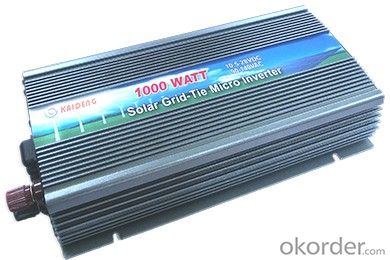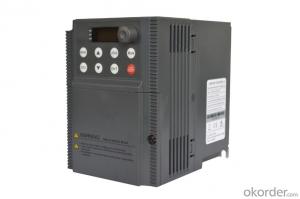1.5kW KD-GTI Series Micro Inverter - Hot Sales, High Quality
- Loading Port:
- China main port
- Payment Terms:
- TT OR LC
- Min Order Qty:
- 1000 pc
- Supply Capability:
- 100000 pc/month
OKorder Service Pledge
OKorder Financial Service
You Might Also Like
Structure
The transition from a centralized to a distributed inverter optimizes energy collection.
The converter module integrated into the solar panels can reduce installation costs.
Soft switch technology to replace hard-switching technology can improve efficiency and reduce heat dissipation.
From cottage industry to mass production, standardized design (hardware and software) to improve reliability and reduce costs.
Using a special capacitor (due to the high failure rate). Design requires a higher voltage to reduce the current, we use a special electrolytic capacitors.
The converter can be connected to the grid to eliminate the need for many battery applications. The high price of batteries, require maintenance, life expectancy is shorter.
Work required micro-inverter power increasingly smaller (only a few hundred watts), which can reduce the internal temperature and improve reliability.
Micro-inverter solar inverter system needs to deal with a lot of a particular power level, in order to increase production, thereby reducing costs.
DC input voltage range:10.5-28VDC
AC output voltage range:80-160VAC/180-260VAC
AC output power :950Wp
AC frequency range:50Hz/60Hz
G.W.:2.4
Size:394mm*209mm*117mm
KD-GTI Series Using IP67 waterproof streamline design, Can effectively prevent rainwater on the surface erosion, Built-in high-performance Maximum Power Point Tracking(MPPT)Function,Better able to track changes in the solar luminosity and control different output power, Effectively capture and collect sunlight. AC electric power transmission using the reverse transmission technology, Is one of our patented technology, The inverter output power can provide load priority use, Extra electricity to the grid, Efficient use of the inverter to the power emitted, Electricity transmission rate of up to 99%.
Features
Pure Sine Wave Output;
High performance Maximum Power Point Tracking(MPPT);
Power Automatically Locked(APL);
Reverse power transmission;
High-Frequency High Conversion Rate;
Anti-Islanding Protect;
Input /output is fully isolated to protect the electrical safety;
Multiple parallel stacking;
The Leading Patent Technology;
IP65 WaterProof;
Flexible Installation;
Simplify maintenance (user serviceable)
High Efficiency & Best Cost-Effectiveness
Images


Specification
Input Data | KD-WV250-120VAC/230VAC | |||
Recommended input power | 200-300Watt | |||
Recommend the use of PV modules | 300W/Vmp>34V/Voc<50v< span=""> | |||
Maximum input DC voltage | 50V | |||
Peak power tracking voltage | 25-40V | |||
Operating Voltage Range | 17-50V | |||
Min / Max start voltage | 22-50V | |||
Maximum DC short current | 15A | |||
Maximum Input Current | 9.8A | |||
Output Data | @120VAC | @230VAC | ||
Peak power output | 260Watt | 260Watt | ||
Rated output power | 250Watt | 250Watt | ||
Rated output current | 2.08A | 0.92A | ||
Rated voltage range | 80-160VAC | 180-260VAC | ||
Rated frequency range | 57-62.5Hz | 47-52.5Hz | ||
Power factor | >96% | >96% | ||
Maximum units per branch circuit | 15PCS(Single-phase) | 30PCS(Single-phase) | ||
Output Efficiency | @120VAC | @230VAC | ||
Static MPPT efficiency | 99.5% | 99.5% | ||
Maximum output efficiency | 92.3% | 94.6% | ||
The average efficiency | 91.2% | 93.1% | ||
Night time power consumption | <50mW Max | <70mW Max | ||
THDI | <5%< span=""> | <5%< span=""> | ||
Exterior | ||||
Ambient temperature | -40°C to +60°C | |||
Operating temperature range (inverter inside) | -40°C to +82°C | |||
Dimensions (WxHxD) | 191mm*1176mm*38mm | |||
Weight | 0.83kg | |||
Waterproof Rating | IP65 | |||
Cooling | Self-cooling | |||
Feature | ||||
Power transmission mode | Reverse transfer, load priority | |||
Electromagnetic compatibility | EN50081.part1EN50082.part1 | |||
Grid disturbance | EN61000-3-2 Safety EN62109 | |||
Grid detection | DIN VDE 1026 UL1741 | |||
Certificate | CEC,CE National patent technology | |||
The transition from a centralized to a distributed inverter optimizes energy collection.
The converter module integrated into the solar panels can reduce installation costs.
Soft switch technology to replace hard-switching technology can improve efficiency and reduce heat dissipation.
From cottage industry to mass production, standardized design (hardware and software) to improve reliability and reduce costs.
Using a special capacitor (due to the high failure rate). Design requires a higher voltage to reduce the current, we use a special electrolytic capacitors.
The converter can be connected to the grid to eliminate the need for many battery applications. The high price of batteries, require maintenance, life expectancy is shorter.
Work required micro-inverter power increasingly smaller (only a few hundred watts), which can reduce the internal temperature and improve reliability.
Micro-inverter solar inverter system needs to deal with a lot of a particular power level, in order to increase production, thereby reducing costs.
FAQ
Can we visit your factory?
Surely, I will arrange the trip basing on your business schedule.
Can you do OEM for us?
Yes, we can.
How do you pack your products?
We have rich experience on how to pack the panels to make sure the safety on shipment when it arrives at the destination.
Can you help us install the module if we cooperate with you?
We haven’t entered into installation sector, but we have the plan in near future.
- Q: Can a solar inverter be used in standalone power systems?
- Yes, a solar inverter can be used in standalone power systems. Standalone power systems, also known as off-grid systems, are not connected to the main electricity grid and rely on alternative energy sources like solar panels. A solar inverter converts the direct current (DC) generated by the solar panels into usable alternating current (AC) electricity, which can power various electrical devices in standalone power systems.
- Q: How does a solar inverter handle voltage and frequency variations caused by sudden load changes?
- A solar inverter handles voltage and frequency variations caused by sudden load changes by continuously monitoring and adjusting its output. It uses advanced control algorithms to maintain a stable voltage and frequency, even during sudden load fluctuations. The inverter quickly responds to changes in load demand by adjusting the power output and employing a feedback control system that regulates voltage and frequency within acceptable limits. This ensures that the connected devices receive a stable and reliable power supply regardless of sudden load changes.
- Q: How does a solar inverter handle voltage unbalance in the grid?
- A solar inverter handles voltage unbalance in the grid by continuously monitoring the incoming voltage levels. If it detects a voltage imbalance, it automatically adjusts its internal control mechanisms to balance the output voltage and ensure stable operation. Additionally, the inverter may also employ advanced algorithms to mitigate the effects of voltage unbalance, such as reactive power compensation and voltage regulation, minimizing any potential impacts on the solar system's performance and the grid.
- Q: Can a solar inverter be used with both AC and DC power sources?
- No, a solar inverter is designed to convert DC power from solar panels into AC power for use in standard electrical systems. It cannot be used with both AC and DC power sources simultaneously.
- Q: What is the maximum input voltage for a solar inverter?
- The maximum input voltage for a solar inverter typically depends on the specific model and manufacturer. However, in general, solar inverters are designed to handle input voltages ranging from around 250 to 600 volts.
- Q: What is the role of a solar inverter in reactive power control?
- The role of a solar inverter in reactive power control is to manage and regulate the flow of reactive power in a solar power system. It helps to maintain the power factor within acceptable limits by either injecting or absorbing reactive power as needed. This ensures efficient and stable operation of the system, while also preventing voltage fluctuations and grid instability.
- Q: How does a solar inverter handle voltage regulation during high demand?
- A solar inverter handles voltage regulation during high demand by constantly monitoring the grid voltage and adjusting its output accordingly. When there is high demand, the inverter ramps up its power output to ensure that the voltage remains stable and within the acceptable range. It does so by regulating the reactive power flow and employing advanced control algorithms to maintain grid stability.
- Q: Can a solar inverter be used with a grid-tied system and a battery backup?
- Yes, a solar inverter can be used with a grid-tied system and a battery backup. In such a setup, the solar inverter will convert the DC power generated by the solar panels into AC power for use in the home or to feed back into the grid. The grid-tied system allows excess solar power to be sold back to the grid, while the battery backup system stores excess power for use during times of low solar generation or power outages.
- Q: What is the role of maximum power control in a solar inverter?
- The role of maximum power control in a solar inverter is to optimize the power output of the photovoltaic (PV) system by continuously tracking the maximum power point (MPP) of the solar panels. This control mechanism ensures that the inverter extracts the maximum amount of energy from the PV array, despite variations in solar irradiation and temperature. By constantly adjusting the inverter's operating conditions to match the MPP, maximum power control maximizes the overall efficiency and performance of the solar power system.
- Q: Are there any safety considerations when installing a solar inverter?
- Yes, there are several safety considerations when installing a solar inverter. First, it is important to ensure that the installation is carried out by a qualified professional who is trained in handling electrical systems. This helps minimize the risk of electric shock or fire hazards. Additionally, proper grounding and insulation must be implemented to prevent electrical faults. It is also crucial to follow the manufacturer's guidelines and local electrical codes to ensure the safe and efficient operation of the inverter.
Send your message to us
1.5kW KD-GTI Series Micro Inverter - Hot Sales, High Quality
- Loading Port:
- China main port
- Payment Terms:
- TT OR LC
- Min Order Qty:
- 1000 pc
- Supply Capability:
- 100000 pc/month
OKorder Service Pledge
OKorder Financial Service
Similar products
Hot products
Hot Searches
Related keywords


























